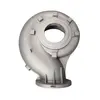Mobile:+86-311-808-126-83
Email:info@ydcastings.com
peristaltic pump tubing connectors
Understanding Peristaltic Pump Tubing and Connectors A Comprehensive Guide
Peristaltic pumps are widely utilized in various industries, including pharmaceuticals, food and beverage, and wastewater treatment. Their unique design allows for accurate fluid transfer with minimal contamination, making them ideal for handling delicate or corrosive substances. One crucial aspect of their operation is the tubing and connectors used in peristaltic pumps, which significantly influence the performance and efficiency of the system.
What is a Peristaltic Pump?
Before diving into tubing and connectors, it's important to understand what a peristaltic pump is. A peristaltic pump works by compressing and relaxing a flexible tube, which creates a series of pressure waves that propel fluid through the tubing. This design ensures a consistent flow rate and allows for the handling of a wide range of fluids, including slurries, viscous liquids, and shear-sensitive substances.
The Role of Tubing in Peristaltic Pumps
The tubing in a peristaltic pump is a crucial component that determines the pump's flow characteristics, chemical compatibility, and overall efficiency. Various types of tubing materials are available, each tailored for specific applications
1. Silicone Tubing Known for its flexibility and resistance to extreme temperatures, silicone tubing is often used in pharmaceutical and food industries. It is non-toxic and can withstand sterilization processes.
2. PVC Tubing Polyvinyl chloride (PVC) is another common tubing material. It is cost-effective and offers good chemical resistance but may not be suitable for high-temperature applications.
3. Tygon Tubing Tygon is a flexible and durable tubing option that can handle a wide range of chemicals. It's ideal for laboratory settings and can be customized based on application needs.
4. Santoprene Tubing This thermoplastic elastomer combines the benefits of rubber and plastic, offering excellent flexibility and chemical resistance. It is often used in automotive and industrial applications.
When selecting tubing, it’s essential to consider factors such as the chemical compatibility of the fluid being pumped, the temperature range, and the required flexibility and durability
. Additionally, the internal diameter of the tubing is critical as it directly affects the flow rate and pressure.Connectors in Peristaltic Pump Systems
peristaltic pump tubing connectors

Connectors play a vital role in ensuring a seamless connection between the tubing and other system components. They must be reliable to prevent leaks, maintain pressure, and ensure ease of maintenance. Two common types of connectors used in peristaltic pump systems are
1. Barbed Connectors These connectors feature tapered ends that create a secure fit with the tubing. The barbed design helps to prevent slippage, making them popular in various applications. However, proper sizing is crucial to avoid damaging the tubing during installation.
2. Quick Connect Fittings For applications requiring frequent disconnection and reconnection, quick connect fittings offer convenience and efficiency. They allow for quick changes without needing to cut or damage the tubing, which can be a significant advantage in time-sensitive operations.
When selecting connectors, it is essential to ensure they are compatible with the chosen tubing material to prevent degradation over time. For instance, using plastic connectors with metal tubing may lead to leaks due to thermal expansion differences.
Maintenance and Best Practices
Regular maintenance of tubing and connectors is vital to ensure the longevity and efficiency of peristaltic pump systems. Here are some best practices
- Routine Inspection Regularly check for signs of wear, such as cracks or discoloration in the tubing, and replace them if necessary.
- Proper Cleaning Depending on the fluid being handled, ensure proper cleaning of both tubing and connectors to prevent contamination, particularly in food and pharmaceutical applications.
- Correct Installation Always follow manufacturer guidelines for installation to avoid over-tightening connectors, which can damage the tubing.
Conclusion
Understanding the significance of peristaltic pump tubing and connectors is crucial for maintaining efficient pumping systems. By selecting the right materials and ensuring proper maintenance, industries can optimize their operations, reduce downtime, and enhance the overall performance of their peristaltic pumps. Whether in a laboratory, manufacturing facility, or any other application, knowledgeable choices in tubing and connectors can lead to significant long-term benefits.
-
Why Should You Invest in Superior Pump Castings for Your Equipment?NewsJun.09,2025
-
Unlock Performance Potential with Stainless Impellers and Aluminum End CapsNewsJun.09,2025
-
Revolutionize Your Machinery with Superior Cast Iron and Aluminum ComponentsNewsJun.09,2025
-
Revolutionize Fluid Dynamics with Premium Pump ComponentsNewsJun.09,2025
-
Optimizing Industrial Systems with Essential Valve ComponentsNewsJun.09,2025
-
Elevate Grid Efficiency with High-Precision Power CastingsNewsJun.09,2025











